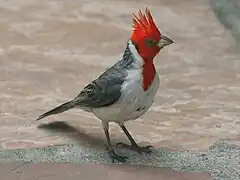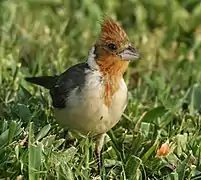Red-crested cardinal
The red-crested cardinal (Paroaria coronata) is a passerine bird in the tanager family Thraupidae. Notwithstanding its similar name, this bird is not closely related to the true cardinal family Cardinalidae. It is sometimes known as the Brazilian cardinal.
| Red-crested cardinal | |
|---|---|
 | |
| At Koke'e State Park, Hawaii | |
| Song of Red-crested Cardinal | |
| Scientific classification | |
| Domain: | Eukaryota |
| Kingdom: | Animalia |
| Phylum: | Chordata |
| Clade: | Dinosauria |
| Class: | Aves |
| Order: | Passeriformes |
| Family: | Thraupidae |
| Genus: | Paroaria |
| Species: | P. coronata |
| Binomial name | |
| Paroaria coronata (Miller, JF, 1776) | |
 | |
Taxonomy
In 1776 the English illustrator John Frederick Miller included a hand-coloured plate of the red-crested cardinal in his Icones animalium et plantarum. He coined the binomial name Loxia coronata.[3] The type locality was subsequently designated as Rio Grande do Sul in southern Brazil.[4] The red-crested cardinal is now one of six species placed in the genus Paroaria that was introduced in 1832 by the French naturalist Charles Lucien Bonaparte. The species is monotypic: no subspecies are recognised.[5] The genus name is from Tiéguacú paroára, a name for a small yellow, red and grey bird in the extinct Tupi language. The specific epithet coronata is Latin meaning "crowned"[6]
Description
The red-crested cardinal is a medium-sized species showing a red head, with a red bib and a short red crest that the bird raises when excited. Belly, breast and undertail are white, with a gray back, wings, and tail. Wing coverts are gray, but the primaries, secondaries, and rectrices show a darker gray. Juveniles are similar to the adults, but they show a dull brownish orange head and bib.[7]
This species is very similar to a close relative, the red-cowled cardinal (P. dominicana). It is also similar to the yellow-billed cardinal (P. capitata), but the latter bird has a black throat, darker upper parts and a bright yellow bill.[7]
Distribution and habitat
This species can be found mainly in Brazil's Rio Grande do Sul, southern part of the Pantanal, northern Argentina, Bolivia, Paraguay and Uruguay.[1][7] It has also been introduced to Hawaii, Puerto Rico and Chile. In Brazil, it has been introduced to various places outside its historical range, as in the Tietê Ecological Park in São Paulo.[8]
Its natural habitats are subtropical or tropical dry shrubland and heavily degraded former forest, at an elevation up to 500 metres (1,600 ft) above sea level.[1] It often occurs close to rivers, marshes and lakes.[7]
Behaviour and ecology
Food and feeding
This species mainly feed on seeds (of Chloris virgata, Eleusine tristachya, Setaria parviflora and Spergula villosa), fruits (of Celtis tala, Grabowskia duplicata, Holmbergia tweedii, Morus alba, and Sapium haematospermum), insects and small arthropods, generally searched for on the ground in pairs or small groups.[7] Average lifespan is about 3.8 years.[1]
Gallery
 Fully displayed crest - Maui, Hawaii
Fully displayed crest - Maui, Hawaii Juvenile - Kapiolani Park - Oahu, Hawaii
Juvenile - Kapiolani Park - Oahu, Hawaii.jpg.webp) Close-up
Close-up- Video clip
References
- BirdLife International (2018). "Paroaria coronata". IUCN Red List of Threatened Species. 2018: e.T22721582A132144578. doi:10.2305/IUCN.UK.2018-2.RLTS.T22721582A132144578.en. Retrieved 13 November 2021.
- "Appendices | CITES". cites.org. Retrieved 2022-01-14.
- Miller, John Frederick (1776). Icones animalium et plantarum. Various subjects of Natural History, wherein are delineated Birds, Animals and many curious Plants, &c (in Latin). London. Part 1, Plate 2. The work was published in 10 parts with 6 plates in each part. See: Sherborn, C.D.; Iredale, T. (1921). "J. F. Miller's Icones". Ibis. 11th series. 3: 302–309.
- Paynter, Raymond A. Jr, ed. (1970). Check-List of Birds of the World. Vol. 13. Cambridge, Massachusetts: Museum of Comparative Zoology. p. 213.
- Gill, Frank; Donsker, David; Rasmussen, Pamela, eds. (July 2023). "Tanagers and allies". IOC World Bird List Version 13.2. International Ornithologists' Union. Retrieved 4 October 2023.
- Jobling, James A. (2010). The Helm Dictionary of Scientific Bird Names. London: Christopher Helm. pp. 293, 118. ISBN 978-1-4081-2501-4.
- Linn, A.; Burns, K.J.; Richart, C.H. (2020). Schulenberg, T.S. (ed.). "Red-crested Cardinal (Paroaria coronata), version 1.0". Birds of the World. Ithaca, NY, USA: Cornell Lab of Ornithology. Retrieved 4 October 2023.
- Parque Ecológico do Tietê
External links
- Red-crested cardinal videos on the Internet Bird Collection
- Stamps (for Argentina, Brazil, Uruguay) with range map
- Red-crested cardinal photo gallery VIREO
